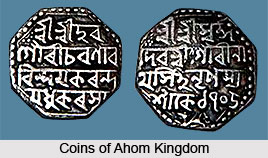 Sudangphaa was an Ahom king who reigned over the Ahom kingdom from 1397 CE to 1407 CE. He was brought up by a Brahman family and was thus popularly called as `Bamuni Konwar` or `the Brahman prince`. During his rule, influence of Hinduism gained prominence in Ahom kingdom, especially the Brahmanical influence. Singarigharutha ceremony was also started by Sudangphaa which is a special ceremony performed during the coronation of kings.
Sudangphaa was an Ahom king who reigned over the Ahom kingdom from 1397 CE to 1407 CE. He was brought up by a Brahman family and was thus popularly called as `Bamuni Konwar` or `the Brahman prince`. During his rule, influence of Hinduism gained prominence in Ahom kingdom, especially the Brahmanical influence. Singarigharutha ceremony was also started by Sudangphaa which is a special ceremony performed during the coronation of kings.
Birth and Early Life of Sudangphaa
Sudangphaa was born to the Ahom king Tyao Khamti and his younger queen. Tyao Khamti had two queens among which the younger one was his favourite. When Tyao Khamti left for a military expedition to take revenge from the Sutiya king who killed his brother Sutuphaa, he granted the charge of the kingdom to his elder queen. During that time his younger queen was pregnant and owing to this the elder queen became immensely jealous as the king`s favourite queen was about to give birth to his first child, which will eventually raise her position. Thus, by taking advantage of her position, the elder queen posed false allegations against her and ordered her to be executed. However, the ministers, considering her condition spared her from killing and set her adrift on a raft over Brahmaputra River. The raft after floating for some time landed in Habung village. In the village a Brahman sheltered her. There she gave birth to a boy and died after revealing her son`s true identity to the Brahman. Thus the boy spent his childhood in the Brahman family.
Coronation of Sudangphaa
After the death of king Tyao Khamti, the kingdom was ruled by Chaothai Khum Burhagohain and Borgohain from 1389 CE to 1397 CE, as there was no suitable candidate to become the king. In 1397 CE Thao Cheoken, an Ahom trader went across Brahmaputra River for cattle trade. There at Habung village he saw the prince and was curious by his noble appearance among the other villagers. When he enquired about him, he came to know about his identity as king Tyao Khamti`s son. Burhagohain after verifying the truth and consulting other ministers brought the prince at the capital Charaideo and coronated him as king. He was named as Sudangphaa in the Ahom kingdom.
Sudangphaa along with him brought the Brahman who had given him shelter with his sons to the kingdom. He gave the sons significant positions and installed the Brahman as his confidential adviser. After this, a number of Hindu rituals and practices emerged in this region. Prayer of Lakshmi-Narayan Salgram was also introduced in the palace of the king.
Conspiracies of Tipam Cheifs
With the initiation of the rule of new king, the Tipam Chiefs were highly dissatisfied and hence plotted a conspiracy against him. When the king came to know about it, he did not take any direct actions against the conspirators, instead ordered to build a stockade for catching elephants. After catching some elephants, he organized a feast as a celebration and asked the conspirators to join it. Among the celebrations, the conspirators were suddenly attacked and executed. A custom prevailed in Ahom kingdom as well as in several Asiatic tribes in which their heads were heaped as a trophy.
Expedition against Mungkang
Mungkang was a shan state of upper Burma which was involved in a war with Sudangphaa. The reason for the war has been stated differently in different chronicles. Some chronicles say that Sudangphaa, in order to pacify the rest of the Tipamias, proposed to marry the daughter of Khuntai, a chief of the kingdom. However the girl and another Tipamia called Tai Sulai wanted to marry each other and knowing about the king`s intention, Tai Sulai went to the king of Mungkang for help. According to other historians, Tai Sulai was the younger brother of Tyao Khamti and he had tried to become the king but was opposed by the nobles of Ahom kingdom. When Sudangphaa was installed as the king Tai Chulai went to Mungkang and told the ruler that Ahom kingdom was in a state of anarchy. As Mungkangs considered Ahom dynasty as their kinsmen, the ruler sent a military expedition in the Ahom kingdom which led to a battle. Mungkangs were defeated in the battle. Sudangphaa decided to shift his capital to Charguwa, near Dihing River, from Charaideo after making a peace treaty with Mungkang in 1403 CE.
Expedition against Kamata Kingdom
Tai Sulai took refuge in the Kamata kingdom after the lost battle. On refusing Sudangphaa`s orders for extradition of Tai Sulai by the Kamata ruler, Sudangphaa invaded their kingdom. At the same time, Muslim rulers of Bengal were also invading Kamata kingdom and so the Kamata king desired to make peace with the Ahoms. The ruler gave one of his daughters to Sudangphaa in marriage along with a dowry of several horses, two elephants, male and female servants and huge quantities of gold and silver.
Sudangphaa ruled for about 10 years and died in 1407. In ancient records he had been described as a young, dynamic and energetic king. He handled numerous threats and conflicts during his reign with wit and determination.



















